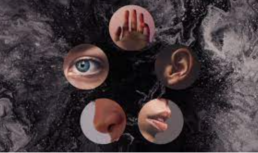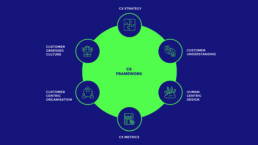Create emotional engagement with your customers: stimulate the five senses
In previous journey mapping sessions we have done with our clients, we look at the main journey phases and always map at least three elements: the customer needs, customer actions (what they do) and customer emotions (how it makes them feel). Zooming in on the emotions is an effective way to see where to take action to improve the experience. This can be done by fixing pain points or by creating extra value points. From there we go to find the best solutions: the ones that create maximum customer value at a relatively low implementation effort for the organization. Quite straightforward.
So far, this is nothing unusual. But not every company consciously looks at their journey to see where they can stimulate the right human senses. We think this could or rather, should be a very relevant part of every journey mapping exercise.
Why is stimulating the senses important?
Science shows that by stimulating the senses, you will appeal to what is known as the customer’s first brain. This brain is the oldest brain; it has been around there for 500 million years, and it is common among most animals. It is primitive and emotional! It manages the unconscious thoughts and plays an essential role in the overall customer experience and how it makes customers feel.
How to stimulate the senses?
There are numerous examples of the use of senses in retail environment, hospitality, and airline industry. I am going to give you some examples used in the airline industry, of course it can be applied to any industry where there is physical contact between the company and its customers.
Sight
Customers depend more on sight than on any other senses to navigate through a physical environment. At first glance, a first impression is formed. When you enter an aircraft of Virgin Atlantic, you don’t have the feeling that you are walking through a working area for crew with containers, like with most airlines. No, next to a welcoming crew, you see a nice bar and the right lighting that sets a comfortable mood. This nice atmosphere makes you feel relaxed. Suddenly you are looking forward to your 10 hour flight.
Hearing
Sound, especially music, can bring the visual world to life and can bring back memories. Virgin played poppy music from Blondie to Kylie Minogue and David Guetta. Delta Airlines played Pharell William’s Happy during boarding and disembarking the aircraft. It works both ways: when you hear the music on board, it stimulates a positive mood. And when you hear it back home, it might bring back Delta memories.
Smell
Smell is a powerful sense. It is the strongest trigger of emotional memory. I am sure if you smell the perfume that your mother used many years ago, it will bring you back to your childhood. Airlines also invest in scent marketing. Since the 1990s, Singapore Airlines has created its own fragrance as its scent brand. But it can be applied in other ways: Delta Airlines was famous for serving chocolate chip cookies on board. By heating them, the whole cabin could smell it and long for the upcoming treat.
Taste
Free tasting options are used at many food courts, as it increases the overall sales. But also outside of the food business you can use it. Some airlines offer free cookies in baggage reclaim areas, managing perception about waiting times. And seen from a different perspective: as your taste on board of an aircraft is different than on the ground, it brings some extra challenges to provide tasty meals and good tasting (not too acid) wines on board.
Touch
Touching something moves it from a representation / an idea to something true. Although with Covid-19 this has changed, instinctively people want to touch something to get a better idea of it or to check or experience the quality. You choose to use what you enjoy touching! For airlines, attention is now being paid to high quality amenities and good bed linen in First Class cabins.
So what can this mean for you your company and your customers?
Have a look at your company’s customer journey and see where you trigger which senses
- Where in the journey does your customer see, hear, smell, taste or touch?
- Which emotional reactions does and/or can it trigger?
- Does it enhance the customer experience? Or could it have negative impact?
Both in general as well compared to your desired experience and brand positioning?
Want to know more on how to trigger your customer’s senses and improve the emotional engagement? And how to embed this in your journey mapping exercise? Please contact us at hello@cxunraveled.com
What do your customers really want? How to make Jobs To Be Done!
A few months ago, we talked about Jobs To Be Done and the 5 key elements you should be aware of when starting to formulate the JTBD's for your own company. We made clear that companies should define the market they’re in from perspective of the Jobs that their customers are trying to achieve, not the current products the company is offering. Products are just a solution meeting a customer need. These solutions will be replaced if a better one comes to market. For the full article on introduction of JTBD, please check out https://cxunraveled.com/jobs-to-de-done/
Using JTBD can help you to move away from the current solution and open a new perspective and look for opportunities for new solutions. Or it makes it clear what current product features don’t give value to the customer’s Job.
But how to write your Job to be Done for your own customers?
Like with many CX and service design tools and concepts, we have a template for that ;-)
When ____ (situation), I want to _____ (motivation) so that I can _____ (expected outcome)
JTBD can be used in every business context as well as in your personal context. We all have many jobs to do every day! Sounds busy? Doesn’t have to be, as long as you find a good solution for your job to relax at certain times, it will be fine!
Some examples make it more concrete:
- When I am on board of a long flight, I want to be entertained so that I won’t get bored
The airline will try to find a solution to entertain their customers by offering free movies and wifi. Or they could also directly target the desired customer outcome (not getting bored) by offering some extra service and personal attention
- When I move to my new apartment, I want to have energy supply, so that I can heat my home
- When I received a new painting for my birthday, I want to hang it on my wall in my living room, so I can enjoy it every day while I sit on the couch
To hang the painting, customers will buy (or rent) a drill. Not because they want to have a drill, but because they need a hole in the wall to attach the painting. If new solutions like a very strong scotch tape, or self-attaching paintings will come on the market, customers won’t look for a drill anymore to hang a painting.
Personas and Jobs To Be Done
Personas let you step into the shoes of your customers. They tell who your customers are, what they do and what makes them tick and what doesn’t.
As you can see, JTBD start with describing a specific situation – the context – and pinpoints what is motivating / driving a customer for that specific job to potentially interact with you.
We think that JTBD are a valuable addition to personas, so that you can not only empathize with your customers but also optimize or innovate your current solutions. Our advice is to identify the JTBD specifically for every persona in each customer journey they have with your company to get the best result.
We hope this clarifies and makes you start using jobs to be done within your own company. If your job to be done in reading this blog was to learn how to formulate a JTBD for your customers, then I hope this helped!
Customer Experience Framework
CX Framework - 6 disciplines you need to master to excel in Customer Experience
More and more companies are now realizing that Customer Experience is the new competitive battleground for businesses. They vow to be customer focused and look at solving pre existing blind spots. But to break out of the find-and-fix cycle and find ways to differentiate yourself as a company, you need to make the next step: managing from your customer’s perspective in a systematic, repeatable and disciplined way. To do that, you need to routinely perform the 6 disciplines from the CX Framework. This Framework is being used by the CXPA (Customer Experience Professional Organization) and also by CX Unraveled in our offer of Deepdive Masterclasses. In this blog, I break down these 6 competences in an easy to digest way:
- CX Strategy
‘Good experiences don’t happen by accident, they are created by design’
This is your north star, or game plan: here you describe the intended CX you want to deliver, and you make sure it is linked to your overall company strategy, brand values and customer needs.
- Customer Understanding
‘Know what your customers want most and your company does best’
Key input for all other disciplines is your 360” customer view: Understanding who your customers are, their wants, needs, and how they perceive interactions with your company.
- Human Centered Design
‘Solve the right problem before you solve the problem right’
Following a structured design process is needed any time a pain point is fixed or a value point is created. Key is to have this process human centered, collaborative, and iterative.
- Customer Centric Organization
Key is to schedule your priorities, not to prioritize your schedule
Here it’s all about getting things done, and making sure that you manage CX in a disciplined and proactive way. Break the silos and have shared priorities and accountability.
- CX Metrics
If you can’t measure it, you can’t improve it
With the right metrics being put in your CX KPI framework, you can quantify your CX quality in a consistent manner, monitor your progress, and put CX at par with financial KPIs.
- Customer Obsessed Culture
Culture eats strategy for breakfast
This is your company DNA: shared values and behaviors of your staff needed to deliver great CX. This is what your employees do when you’re not in the room and is key in CX delivery.
More info per discipline can be found at the description section of our DeepDive Masterclasses. Additionally, in our upcoming blogs we will get back to some questions we often get on these disciplines. Questions such as: how are they related, where to start, is there a needed order in development, how mature are companies on the various elements and which topics are covered where?


